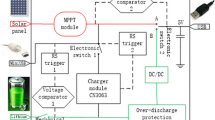Abstract
A power monitoring and protection system based on an embedded processor was designed for the junction boxes (JBs) of an experimental seafloor observatory network in China. The system exhibits high reliability, fast response, and high real-time performance. A two-step power management method which uses metal-oxide-semiconductor field-effect transistors (MOSFETs) and a mechanical contactor in series was adopted to generate a reliable power switch, to limit surge currents and to facilitate automatic protection. Grounding fault diagnosis and environmental monitoring were conducted by designing a grounding fault detection circuit and by using selected sensors, respectively. The data collected from the JBs must be time-stamped for analysis and for correlation with other events and data. A highly precise system time, which is necessary for synchronizing the times within and across nodes, was generated through the IEEE 1588 (precision clock synchronization protocol for networked measurement and control systems) time synchronization method. In this method, time packets were exchanged between the grandmaster clock at the shore station and the slave clock module of the system. All the sections were verified individually in the laboratory prior to a sea trial. Finally, a subsystem for power monitoring and protection was integrated into the complete node system, installed in a frame, and deployed in the South China Sea. Results of the laboratory and sea trial experiments demonstrated that the developed system was effective, stable, reliable, and suitable for continuous deep-sea operation.
Similar content being viewed by others
References
Aguzzi, J., Mànuel, A., Condal, F., et al., 2011. The new seafloor observatory (OBSEA) for remote and long-term coastal ecosystem monitoring. Sensors, 11(6):5850–5872. [doi:10.3390/s110605850]
Barnes, C.R., Tunnicliffe, V., 2008. Building the world’s first multi-node cabled ocean observatories (NEPTUNE Canada and VENUS, Canada): science, realities, challenges and opportunities. Proc. OCEANS, p.1–8. [doi:10.1109/OCEANSKOBE.2008.4531076]
Cena, G., Bertolotti, I.C., Scanzio, S., et al., 2012. Evaluation of EtherCAT distributed clock performance. IEEE Trans. Ind. Inform., 8(1):20–29. [doi:10.1109/TII.2011.2172434]
Chan, T., 2007. Analytical Methods for Power Monitoring and Control in an Underwater Observatory. PhD Thesis, University of Washington, USA.
Chave, A.D., Waterworth, G., Maffei, A.R., et al., 2004. Cabled ocean observatory systems. Mar. Technol. Soc. J., 38(2):30–43. [doi:10.4031/002533204787522785]
Chen, Y.H., Yang, C.J., Li, D.J., et al., 2012. Development of a direct current power system for a multi-node cabled ocean observatory system. J. Zhejiang Univ.-Sci. C (Comput. & Electron.), 13(8):613–623. [doi:10.1631/jzus. C1100381]
Chen, Y.H., Yang, C.J., Li, D.J., et al., 2013. Study on 10 kV DC powered junction box for a cabled ocean observatory system. China Ocean Eng., 27(2):265–275. [doi:10.1007/s13344-013-0023-y]
del Río, J., Toma, D., Shariat-Panahi, S., et al., 2012. Precision timing in ocean sensor systems. Meas. Sci. Technol., 23(2):025801.1–025801.7. [doi:10.1088/0957-0233/23/2/025801]
Dewey, R., Tunnicliffe, V., 2003. VENUS: future science on a coastal mid-depth observatory. Proc. 3rd Int. Workshop on Scientific Use of Submarine Cables and Related Technologies, p.232–233. [doi:10.1109/SSC.2003. 1224149]
Han, J., Jeong, D., 2010. A practical implementation of IEEE 1588-2008 transparent clock for distributed measurement and control systems. IEEE Trans. Instrument. Meas., 59(2):433–439. [doi:10.1109/TIM.2009.2024371]
Howe, B.M., Chan, T., El-Sharkawi, M., et al., 2006. Power System for the MARS Ocean Cabled Observatory. Available from http://neptunepower.apl.washington.edu/publications/documents/psftmoco.pdf[Accessed on Mar. 9, 2015].
Hsu, S.K., Lee, C.S., Shin, T.C., et al., 2007. Marine cable hosted observatory (MACHO) project in Taiwan. Proc. Symp. on Underwater Technology and Workshop on Scientific Use of Submarine Cables and Related Technologies, p.305–307. [doi:10.1109/UT.2007.370808]
Ioannides, M.G., 2004. Design and implementation of PLCbased monitoring control system for induction motor. IEEE Trans. Energy Conv., 19(3):469–476. [doi:10.1109/TEC.2003.822303]
Kawaguchi, K., Kaneda, Y., Araki, E., 2008. The DONET: a real-time seafloor research infrastructure for the precise earthquake and tsunami monitoring. Proc. OCEANS, p.1–4. [doi:10.1109/OCEANSKOBE.2008.4530918]
Lentz, S., Lécroart, A., 2009. Precision timing in the NEPTUNE Canada network. Proc. OCEANS, p.1–5. [doi:10. 1109/OCEANSE.2009.5278121]
Li, D.J., Wang, G., Yang, C.J., et al., 2013. IEEE 1588 based time synchronization system for a seafloor observatory network. J. Zhejiang Univ.-Sci. C (Comput. & Electron.), 14(10):766–776. [doi:10.1631/jzus.C1300084]
Li, D.J., Wang, J., Zhang, Z.F., et al., 2015. Research and implementation of an IEEE 1588 PTP-based time synchronization system for Chinese experimental ocean observatory network. Mar. Technol. Soc. J., 49(1):47–58. [doi:10.4031/MTSJ.49.1.10]
Lu, S., 2006. Infrastructure, Operations, and Circuits Design of an Undersea Power System. PhD Thesis, University of Washington, USA.
Milevsky, A., Walrod, J., 2008. Development and test of IEEE 1588 precision timing protocol for ocean observatory networks. Proc. OCEANS, p.1–7. [doi:10.1109/OCEANS.2008.5152029]
Ouellette, M., Ji, K., Liu, S., et al., 2011. Using IEEE 1588 and boundary clocks for clock synchronization in telecom networks. IEEE Commun. Mag., 49(2):164–171. [doi:10.1109/MCOM.2011.5706325]
Pirenne, B., Guillemot, E., 2009. The data management system for the VENUS and NEPTUNE cabled observatories. Proc. OCEANS, p.1–4. [doi:10.1109/OCEANSE.2009. 5278187]
Qi, J., Wang, L., Jia, H., et al., 2010. Design and performance evaluation of networked data acquisition systems based on EtherCAT. Proc. 2nd IEEE Int. Conf. on Information Management and Engineering, p.467–469. [doi:10. 1109/ICIME.2010.5478109]
Sun, T., Zhao, B., Li, F., 2011. Application of WinCC in carplant monitoring system. Proc. Int. Symp. on Computer Science and Society, p.203–205. [doi:10.1109/ISCCS. 2011.63]
Woodroffe, A.M., Pridie, S.W., Druce, G., 2008. The NEPTUNE Canada junction box-interfacing science instruments to sub-sea cabled observatories. Proc. OCEANS, p.1–5. [doi:10.1109/OCEANSKOBE.2008.4531021]
Yu, Y., Xu, H., Jiang, E., 2011. The primary research of the junction box based seafloor observatory remote control system. Proc. Int. Conf. on Multimedia Technology, p.3750–3753. [doi:10.1109/ICMT.2011.6002721]
Author information
Authors and Affiliations
Corresponding author
Additional information
Project supported by the National High-Tech R&D Program (863 Program) of China (Nos. 2012AA09A408 and 2012AA09A402), the National Natural Science Foundation of China (No. 51409229), and the Zhejiang Provincial Natural Science Foundation of China (No. LQ14E070002)
ORCID: Jun WANG, http://orcid.org/0000-0002-3291-7214
Rights and permissions
About this article
Cite this article
Wang, J., Li, Dj., Yang, Cj. et al. Developing a power monitoring and protection system for the junction boxes of an experimental seafloor observatory network. Frontiers Inf Technol Electronic Eng 16, 1034–1045 (2015). https://doi.org/10.1631/FITEE.1500099
Received:
Accepted:
Published:
Issue Date:
DOI: https://doi.org/10.1631/FITEE.1500099
Keywords
- Power monitoring and protection
- Embedded processor
- Seafloor observatory network
- IEEE 1588
- Junction boxes




